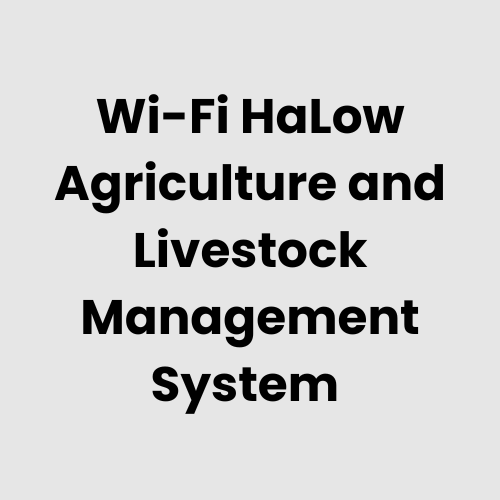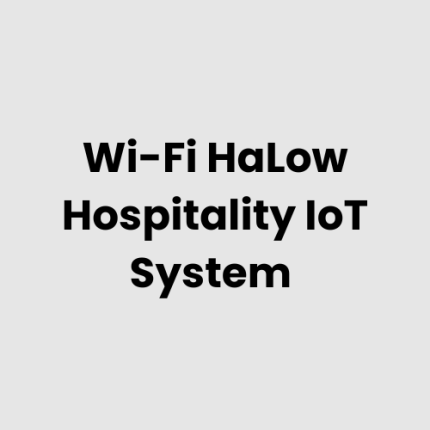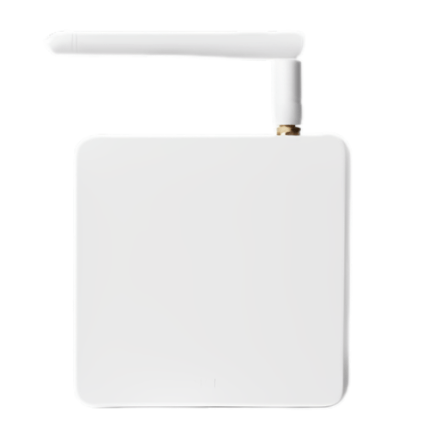Description
Wi-Fi HaLow Agriculture and Livestock Management System: Technical Architecture
The Wi-Fi HaLow Agriculture and Livestock Management System is designed to optimize farm operations through the Internet of Things (IoT) technology. By leveraging the unique capabilities of Wi-Fi HaLow, a long-range and low-power connectivity standard, the system enables real-time monitoring and management of agricultural and livestock operations. This technology enhances productivity, improves resource usage, and ensures the well-being of livestock.
The technical architecture of the Wi-Fi HaLow Agriculture and Livestock Management System integrates several components that work together seamlessly:
- Connectivity Layer: Utilizing Wi-Fi HaLow (IEEE 802.11ah), this system ensures reliable, low-power, and long-range connectivity over large areas like farms and pastures. Wi-Fi HaLow’s ability to support numerous devices and operate over great distances makes it ideal for agricultural applications, providing robust communication even in remote locations.
- Sensor and Device Layer: A variety of IoT sensors and devices are deployed to gather data about soil moisture, temperature, livestock health, and environmental conditions. These devices include soil sensors, water level sensors, GPS trackers for livestock, environmental sensors, and more. These sensors collect real-time data and transmit it via the Wi-Fi HaLow network for processing and analysis.
- Edge Computing Layer: Edge devices are used to process data locally on the farm. By performing initial data filtering and analysis on-site, the system reduces latency and avoids overloading the network with redundant data. This is particularly crucial in areas where connectivity might be intermittent.
- Data Management and Cloud Layer: The data collected from the sensors is sent to a central cloud-based system or local servers for further processing, storage, and analysis. This cloud layer allows farmers to monitor and analyze trends over time, predict crop yields, optimize livestock management, and receive real-time alerts about potential issues.
- Security and Privacy Layer: Ensuring data security is paramount in agricultural operations. The system incorporates encryption, secure access controls, and other measures to protect the integrity and confidentiality of the collected data.
Hardware Components of the Wi-Fi HaLow Agriculture and Livestock Management System
The hardware of the Wi-Fi HaLow Agriculture and Livestock Management System is designed to handle the unique challenges of agricultural environments, providing real-time monitoring, control, and data transmission:
- Wi-Fi HaLow Routers and Gateways: These devices provide the backbone for the system, offering long-range connectivity to ensure data flows smoothly between sensors, devices, and the central management system. They are critical in maintaining strong, stable communication even across large agricultural properties.
- IoT Sensors:
- Soil Sensors: These sensors monitor soil moisture, pH levels, temperature, and other critical factors for crop growth.
- Water Level Sensors: These sensors ensure that irrigation systems are functioning efficiently by detecting water levels in reservoirs, tanks, or irrigation channels.
- Livestock GPS Trackers: These devices track the location and movement of livestock in real time, helping farmers to monitor animal behavior and prevent loss or theft.
- Environmental Sensors: These sensors track temperature, humidity, and other environmental variables to ensure that both crops and livestock are in optimal conditions.
- Edge Computing Devices: These devices handle real-time data processing on-site, reducing the amount of data sent to the cloud and ensuring faster response times. This is critical for real-time decision-making, such as activating irrigation systems or alerting people about abnormal conditions.
- Local Servers: For farms requiring a more localized approach, servers can be installed on-site to process and store data. This is ideal for remote locations where consistent cloud access may be unreliable.
- Monitoring Consoles: These consoles provide a user interface for farmers and farm managers to monitor the system’s status, view data analytics, and receive alerts. They can be accessed locally or remotely, ensuring constant oversight.
- Actuators and Control Systems: Actuators like automated irrigation controllers, feeding systems, and climate control systems allow the system to take corrective actions based on the real-time data it receives from the sensors.
Physical Placement Considerations of the Hardware
Effective deployment of the Wi-Fi HaLow Agriculture and Livestock Management System depends on strategic placement of hardware to ensure optimal performance:
- Wi-Fi HaLow Routers and Gateways: These should be placed in central locations that offer the best coverage for the entire farm, ensuring the signal reaches all sensors and devices. In large fields or open areas, multiple gateways may be required to ensure connectivity across the entire space.
- IoT Sensors: The placement of sensors should align with the specific tasks they monitor:
- Soil Sensors should be placed at varying depths and positions across the field to give a comprehensive overview of soil conditions.
- Water Level Sensors should be positioned in irrigation channels, tanks, or water storage facilities to monitor water levels.
- GPS Trackers for Livestock should be attached to livestock collars to ensure accurate tracking.
- Environmental Sensors should be placed in greenhouses, barns, and other key areas where environmental conditions need monitoring.
- Edge Devices: These should be placed close to sensor clusters to minimize data transmission delays and enable local data processing, particularly in areas where real-time decision-making is critical, such as irrigation control.
- Local Servers: If used, these should be housed in weather-resistant, secure locations, such as farm control rooms or on-site data centers, to ensure that data processing remains uninterrupted.
- Monitoring Consoles: These should be positioned in central farm offices or remotely accessible locations to allow operators to easily access system data and receive notifications.
Hardware Architecture of the Wi-Fi HaLow Agriculture and Livestock Management System
The hardware architecture follows a layered design to ensure seamless operation and efficient management:
- Connectivity Backbone: At the core of the architecture are the Wi-Fi HaLow routers and gateways, which facilitate the long-range communication necessary for IoT sensors and devices to stay connected across vast agricultural properties.
- Sensor Layer: A variety of sensors are deployed in the field, greenhouse, or livestock areas to gather critical environmental and livestock data. These sensors are responsible for detecting soil conditions, water levels, livestock health, and other factors that influence farm operations.
- Edge Devices: These devices provide local data processing, enabling quick decisions based on real-time sensor data. They help minimize network load by processing data on-site before sending it to the cloud or local servers.
- Data Management Layer: This layer aggregates data either on-site (via local servers) or in the cloud. It allows for historical data storage, advanced analytics, and predictive insights that guide agricultural and livestock management decisions.
- Actuation Layer: Based on the processed data, actuators perform tasks such as controlling irrigation, feeding systems, or even automated climate control systems to maintain optimal conditions for crops and animals.
Deployment Considerations of the Wi-Fi HaLow Agriculture and Livestock Management System
When deploying the Wi-Fi HaLow Agriculture and Livestock Management System, the following considerations are crucial to ensure effective and efficient operation:
- Network Coverage: The Wi-Fi HaLow network must be strategically deployed to cover the entire farming area. Depending on the size of the farm, multiple routers or gateways may be necessary to ensure there are no connectivity gaps.
- Sensor Calibration and Placement: Sensors must be correctly calibrated to the specific needs of the farm. Additionally, proper placement in critical areas (e.g., soil, water sources, livestock) ensures accurate data collection.
- Infrastructure Requirements: Evaluate the power and infrastructure needs for deploying sensors and devices in remote or challenging environments. For instance, solar-powered sensors may be required in areas without consistent access to power.
- Data Security: Ensure that proper encryption, authentication, and access controls are in place to protect sensitive farm data, including livestock tracking and crop management information.
- Integration with Existing Systems: The Wi-Fi HaLow Agriculture and Livestock Management System should be integrated with any existing farm management systems to streamline operations and avoid redundancy.
List of Relevant Industry Standards and Regulations
- ISO 27001: Information Security Management
- ISO 9001: Quality Management Systems
- FCC (Federal Communications Commission) Standards
- European Union General Data Protection Regulation (GDPR)
- National Institute of Standards and Technology (NIST) Cybersecurity Framework
- Precision Agriculture Standards (ASABE Standards)
- International Organization for Standardization (ISO) 14001 (Environmental Management)
- Agriculture and Livestock Welfare Standards (varies by region)
Local Server Version: Running with a Local Server
For farms in areas with limited or unreliable internet access, the Wi-Fi HaLow Agriculture and Livestock Management System can operate with a local server. This option allows for:
- Data Processing On-Site: Local servers process data from IoT devices, reducing reliance on cloud-based services and ensuring continuous operation even in remote locations.
- Faster Decision Making: Data can be processed in real-time, enabling immediate responses such as activating irrigation or adjusting livestock care systems without relying on external connectivity.
- Security and Data Control: Data stored locally ensures that sensitive farm information remains secure and under the control of the farm operator.
Cloud Integration and Data Management
The cloud integration of the Wi-Fi HaLow Agriculture and Livestock Management System allows for enhanced data management and scalability:
- Centralized Data Storage: The cloud stores vast amounts of historical and real-time data, allowing farmers to access reports, trends, and insights to guide decision-making.
- Advanced Analytics: Cloud-based analytics tools enable farmers to make data-driven decisions, predicting crop yields, optimizing water usage, and detecting early signs of disease or livestock issues.
- Remote Monitoring: Through cloud-based interfaces, farmers can monitor farm operations remotely, ensuring they stay informed of conditions even when away from the farm.
- Scalability: As farm operations expand, the cloud platform can easily scale to accommodate additional sensors, devices, and more extensive data analysis, without the need for significant hardware upgrades on-site.
GAO Case Studies of Agriculture and Livestock Management
USA Case Studies
- Des Moines, Iowa
Farmers in Des Moines used IoT sensors to monitor soil moisture levels and optimize irrigation systems. These technologies improved crop yields and reduced water wastage. GAO Tek supports such initiatives with advanced IoT solutions that enhance agricultural productivity. Learn about IoT in agriculture.
- Fresno, California
IoT-enabled sensors tracked crop health across vineyards in Fresno, allowing for precise interventions to improve grape quality. GAO Tek provides tools that empower farmers to monitor crops in real time. Discover IoT for crop management.
- Madison, Wisconsin
Dairy farmers near Madison used IoT wearables for livestock to monitor cow health and milk production, leading to enhanced efficiency and animal welfare. GAO Tek’s IoT solutions revolutionized livestock management. Explore IoT for dairy farming.
- Lubbock, Texas
Cotton farmers in Lubbock leveraged IoT systems to analyze soil and environmental conditions, achieving improved crop consistency. GAO Tek delivers IoT technologies for smarter farming practices. Learn about IoT in precision agriculture.
- Gainesville, Florida
IoT sensors in Gainesville monitored the health of citrus orchards, identifying early signs of diseases like citrus greening. GAO Tek offers solutions that promote sustainable orchard management. Discover IoT for orchard health.
- Salinas, California
Lettuce growers in Salinas used IoT solutions to monitor greenhouse environments, ensuring optimal growing conditions. GAO Tek’s IoT products help greenhouse operators maintain efficiency. Learn about IoT for greenhouse management.
- Bismarck, North Dakota
IoT-based weather stations in Bismarck provided real-time data on frost risk, enabling wheat farmers to take preventive measures. GAO Tek supplies robust IoT systems for weather monitoring in agriculture. Explore IoT for weather-based farming.
- Lincoln, Nebraska
IoT systems in Lincoln tracked water usage for corn irrigation, helping to conserve resources while maintaining yields. GAO Tek offers solutions to optimize water management in agriculture. Discover IoT for water efficiency.
- Phoenix, Arizona
IoT devices in Phoenix tracked pest activity, allowing growers to implement targeted pest control strategies. GAO Tek supports pest management with innovative IoT technologies. Learn about IoT for pest control.
- Fort Collins, Colorado
IoT systems were deployed in Fort Collins to monitor livestock grazing patterns, ensuring sustainable pasture management. GAO Tek provides IoT tools for efficient rangeland monitoring. Explore IoT for livestock and pasture.
- Boise, Idaho
Potato farms in Boise employed IoT sensors to monitor soil nutrients and optimize fertilization schedules. GAO Tek’s IoT solutions support nutrient management in farming. Discover IoT for soil management.
- Yakima, Washington
Hop growers in Yakima used IoT sensors to control irrigation and reduce water consumption while maintaining crop quality. GAO Tek offers solutions for efficient resource management in farming. Learn about IoT for sustainable farming.
- Atlanta, Georgia
IoT systems in Atlanta monitored chicken coops to maintain optimal temperature and humidity levels, boosting poultry health. GAO Tek’s IoT technologies enhance livestock housing environments. Explore IoT for poultry farming.
- Columbus, Ohio
IoT systems in Columbus tracked feed levels and automated replenishment in livestock farms, reducing operational costs. GAO Tek helps farmers automate essential processes with IoT tools. Learn about IoT for feed management.
- Lexington, Kentucky
Thoroughbred farms in Lexington used IoT sensors to monitor horse health, ensuring performance optimization. GAO Tek’s IoT systems enhance animal health management. Discover IoT for equine management.
Canada Case Studies
- Regina, Saskatchewan
IoT-enabled drones in Regina monitored crop health across expansive wheat fields, identifying areas requiring intervention. GAO Tek provides advanced IoT technologies for large-scale farming. Learn about IoT in Canadian agriculture.
- Guelph, Ontario
Dairy farms in Guelph adopted IoT solutions to monitor herd behavior and improve milk production through targeted care. GAO Tek supports the Canadian agriculture sector with cutting-edge IoT systems. Discover IoT for dairy optimization.
Navigation menu for Wi-Fi HaLow
- Wi-Fi HaLow Gateways/Routers
- Wi-Fi HaLow End Devices
- Wi-Fi Halow – Cloud, Server, PC & Mobile Systems
- Wi-Fi HaLow Accessories
Navigation Menu for IoT
- LORAWAN
- Wi-Fi HaLow
- Z-WAVE
- BLE & RFID
- NB-IOT
- CELLULAR IOT
- GPS IOT
- IOT SENSORS
- EDGE COMPUTING
- IOT SYSTEMS
Our products are in stock and can be shipped anywhere in the continental U.S. or Canada from our local warehouse. For any further information, please fill out this form or email us.
We are looking for partners. For more information on partnering with GAO, please visit Partner with GAO Tek Inc. It lists various ways to partner with GAO, such as OEM Partnerships, Technology Integration, Distribution and Reselling Opportunities, Presenting at the Leading Event TekSummit, Joint R&D Projects, Training and Consulting Services, Industry-Specific Collaborations, Research and Academic Partnerships.



